Software Can Be a Hard Fix
Based on a story told by Patrick Richardson on the “IEEE
EMC War Stories,” a video memorial tribute to Donald
R. Bush. The story has been transcribed and only (slightly)
dramatized by Chapter Chatter.
When Motorola was in the “Macintosh Clone” business
in the mid-1990’s, Patrick Richardson was working to
re-qualify a “Mac Clone” system that contained an
all-new floppy-disk drive. Testing was going quite well until
they were in the middle of ESD. When even a low-level discharge
was made to the floppy drive, like 2 kV or 4 kV, the whole
system went into a stone cold lock-up. Their first thought
was, “we tested this system before and it passed.”
However, further investigation yielded two very interesting
clues. First, the ESD test on the earlier system configuration
(with the ‘old’ drive) was not done thoroughly.
The test technician had not discharged properly to the floppy-drive.
Second, after the new floppy vendor was called in and a number
of tests were run, the system was re-tested for ESD with the
‘old’ floppy drive installed. Pow! The system locked
up even with the old drive installed (how embarrassing). While
Patrick was dreading the cost and effort of hardening the
new floppy drive for ESD, he was also pondering the previously
mentioned clues. The light came on! Software. The test routine
they used allowed for “retries” when there were
small upsets, like ESD events. Therefore, the systems would
not fail ESD tests if the data drive had small upsets. The
routine would simply go back and try a couple of more times
to write or retrieve the data. The “retry” routine
was also something typically used by the Macintosh OS at that
time. However, a small change had been made in the OS that
shut down the retry routine, even in the test software. So,
when the drive received a small upset, the OS saw it as a
major catastrophe and locked up. After a small software code
fix that allowed the “retries” to take place, the
problem was solved. EMC engineers are the master solution
finders of the technology world – they even fix software
problems! |
Austria
Chapter Chatter apologizes to the Austria Chapter for the omission
of this report from the last two issues. It would be nice to blame
the hard drive or the E-mail server, but it is most likely the
direct fault of the absent minded Associate Editor.
On April 21st, 2004 the Austria Chapter, together with the Institute
for Electronics of the Graz University of Technology and the Austrian
Electrotechnical Association (OVE), organized the 2nd IEEE EMC
Symposium in Austria. The event took place at Austria’s largest
contract research enterprise ARC Seibersdorf Research. Seibersdorf
Research runs an EMC Test Laboratory, which is accredited by the
Austrian Ministry of Economic Affairs and performs EMC research
in close cooperation with industry and university partners. At
the Symposium, 10 speakers presented their research activities
and talked about many different topics like lightning as disturbances,
EMC at the chip-level, new kinds of ferrites, system-checks by
emission measurements with ref-rads, etc. More than 70 participants
attended the one-day symposium, which was sponsored by Würth
Electronics, Rohde & Schwarz, UEI, Austria Microsystems AG,
and the Research Institute for Integrated Circuits. During the
lunch break and after the presentations, the audience had the
opportunity to exchange ideas and to visit a small exhibition.
Following the presentations, there was the possibility to visit
the Seibersdorf EMC Test Lab. It was a great event and very much
appreciated by the attendees. In 2005, the 3rd Symposium will
take place at the Graz University of Technology. For information
on upcoming meetings and to make plans to attend, please visit
the Austrian Chapter’s website at
https://ewh.ieee.org/r8/austria/Chapters/EMC/home.html
Central New England
John Clarke, Co-Chair of the Central New England Chapter, reports
that they have held three meetings since the Summer 2004 issue
of Chapter Chatter. The Chapter held a meeting on Wednesday, July
21. The speaker was Distinguished Lecturer Dr. Michel Ianoz of
the Swiss Institute of Technology at Lausanne, Switzerland. Although
their Chapter meetings are not usually held in July, it was convenient
to hold this meeting when the speaker had planned to be in the
Boston area. In the last 20 years, the widespread use of sensitive
electronic devices has increased the interest in transients, in
particular those caused by lightning (direct and /or indirect).
Dr. Ianoz’ presentation covered the latest developments in
modeling the electromagnetic (indirect) effects of lightning.
The progress in field-to-transmission lines coupling calculations
for networks permits the analysis of more complicated structures
submitted to a lightning electromagnetic field. On Wednesday,
September 29 a presentation was made to the Chapter by Donald
N. Heirman FIEEE, NCE of Don Heirman Consultants, Lincroft, New
Jersey. The speaker is Vice President for Standards of the IEEE
EMC Society and President-Elect of the IEEE Standards Association.
The presentation provided an EMC International Standards Update
covering CISPR SC A and I activity with emphasis above 1 GHz.
Manufacturers and their associated testing organizations whether
internal or third party are being faced with burgeoning EMC requirements
or soon to be EMC requirements, especially above 1 GHz. This has
increased the level of EMC standardization activity with direct
and indirect impact in this frequency and, in some cases, even
below 1 GHz. The presentation discussed the proposed EMC standardization
activity in two international EMC standardization organizations
which are key in the deployment of new EMC standards: first, Subcommittee
A (Radio-Interference Measurements and Statistical Methods) and
second, Subcommittee I (EMC of Information Technology Equipment,
Multimedia and Receivers) of the Special International Committee
on Radio Interference (CISPR) of the International Electrotechnical
Commission (IEC). This was a joint meeting with the Northeast
Product Safety Society (NPSS). On Wednesday, October 27 Distinguished
Lecturer Bruce Archambeault, Ph.D of IBM, North Carolina, presented
the topic: “The Ground Myth.” The term “ground”
is probably the most misused and misunderstood term in EMC engineering,
and in fact in all of circuit design. Ground is considered to
be a zero potential region with zero resistance and zero impedance
at all frequencies. This is not the case in practical high-speed
designs. The speaker discussed the origin of the word
“ground”, what is meant when the term “ground”
is used and how to optimize designs to achieve the overall goals.
Central Texas
The September 2004 meeting of the IEEE EMC Society, Central Texas
Chapter, was held at the Cedar Park, Texas facility of ETS-Lindgren.
The meeting consisted of a great dinner followed by a tour of
the ETS-Lindgren facilities. Points of great interest along the
tour route included the outdoor antenna test and calibration facility,
and the new, CTIA approved antenna and cellular test facility.
In October, the ANSI ASC C63 committees met at ETS-Lindgren over
three days. The Chapter took advantage of the engineering talent
in town and invited Martin Perrine of the FCC in Columbia, Maryland
to give a presentation at its October meeting. After a casual
pizza dinner, Mr. Perrine gave an informative presentation on
“Updated SAR and HAC Requirements.” Mr. Perrine explained
that over the last few years, RF exposure and hearing aid compatibility
have become key items for the development of new technologies,
including FCC rules. Specific Absorption Rate (SAR) has been in
place for a few years as a requirement for various devices, including
cell phones, but a new requirement has come out for Hearing Aid
Compatibility (HAC). The HAC rules involve requirements for phones
to be compatible with hearing aids and this has resulted in a
new standard: ANSI C63.19. Mr. Perrine was involved in both of
these fields and presented on topics related to SAR and the new
requirement of HAC. All in attendance appreciated having an FCC
representative at the local Chapter meeting.
 |
| Meeting attendees at the ETS-Lindgren
outdoor antenna test facility during the Central Texas EMC
Chapter meeting. |
 |
| Dave Staggs addressed the general
meeting of the Central Texas Chapter at its October meeting. |
 |
| John O’Brien of National Instruments,
Central Texas Chapter Chair, in the demo room at ETS-Lindgren. |
 |
| Dr. Michael Foegelle demonstrated
ETS-Lindgren’s new CTIA approved test facility to members
of the Central Texas Chapter. |
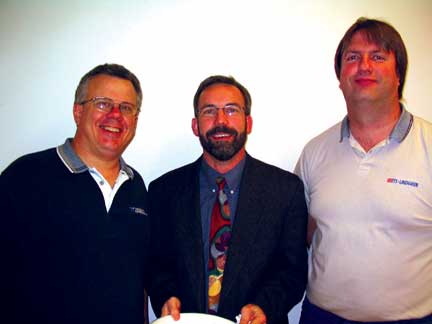 |
| Central Texas Chapter Chair John
O’Brien of National Instruments (far left) visited with
speaker Martin Perrine of the FCC (center) and Michael Foegelle
at the October meeting. |
 |
| The FDA sent representatives to the
October ANSI ASC C63 meetings from Washington, DC who then
stayed on for the Central Texas Chapter meeting, including
(from left) Jon Casamento, Howard Bassen, and Jeff Silberberg. |
Chicago
Frank Krozel reports that the Chicago Chapter enjoyed good weather
(for this time of year) and each other’s company at a sold-out
holiday social event in December at their favorite Dave &
Busters restaurant. Highlights of the event included Dwayne Davis'
balloons and the annual pool party. Several new people visited
and enjoyed the festivities. See the local chapter website for
additional information, including upcoming meeting notices at
www.ewh.ieee.org/ soc/emcs/chicago/ The Chapter is going strong
with well attended monthly meetings. Fall meetings included speakers
Elya Joffe of KTM Project Engineering in Israel and Doug McKinnon
from EmSCAN. The November meeting was a special event since the
EMC Society Board of Directors was in town for their annual Fall
meeting. Board member Don Sweeney and Jack Black of DLS Electronics
organized the meeting at their facility and Board member Elya
Joffe was the invited speaker. Over 70 people attended the meeting
and appreciated the hospitality provided by Don and his staff,
including his wife Marilyn who was the gracious hostess. Along
with the “DLS Girls” Maxine Martin, Carol Gorowski,
and Barbara Inguagiato, the lab was transformed into a gourmet
restaurant complete with fall themed decorations and an excellent
meal. At the conclusion of this special event, Maxine noted “A
good time was had by all!” Come meet the team at the 2005
IEEE International Symposium on EMC at Navy Pier in downtown Chicago!
See our website for additional information, which is updated on
an ongoing basis: www.emc2005.org
 |
| Dwayne Davis enjoys a “wild”
balloon art masterpiece at the Chicago Chapter holiday party. |
 |
| Carla Robinson and “Mike Mackowski”
make a special appearance at the Chicago Chapter holiday party.
|
 |
| Frank and Ida Krozel at the Chicago
Chapter holiday party. |
 |
| Don Sweeney models the latest in
holiday fashion at the Chicago Chapter holiday party as his
wife Marilyn looks on. |
 |
| Brenda and Wally Pilot enjoyed the
Chicago Chapter holiday party. |
 |
| Jack and Michelle Black attended
the Chicago Holiday party. |
 |
| Yaqing Liu, Nick Karnezos, Ray Klouda,
and Jerry Meyerhoff (from left) enjoy the informal networking
at the Chicago Chapter holiday party. |
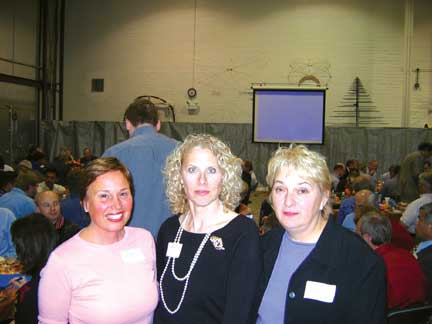 |
| Behind the scenes at DLS Electronics,
site of the November Chicago Chapter meeting, Barbara Inguagiato,
Maxine Martin, and Carol Gorowski (from left) make things
happen! |
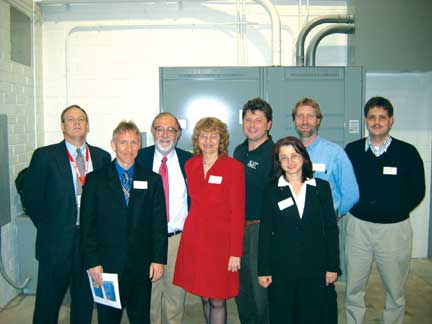 |
| There was a good turn out at the
November Chicago Chapter meeting, including (from left) Chapter
Chair Jack Black, Todd Hubing, Don and Marilyn Sweeney, Jack
Prawica, Zorica Pantic-Tanner, Bill Stumpf, and Frank Sabath. |
 |
| Jim Klouda, Don Heirman, Fred Nearing,
and Norm Wehling (from left) at the November Chicago meeting.
Fred is the founder of Electronic Instrument Associates while
Jim is the founder of Elite Electronic Engineering, two popular
companies in the greater Chicago area. |
 |
| The start of the November Chicago
Chapter meeting. Note the beautiful pumpkin centerpieces on
the tables! |
Dallas
Mark Szewczul, Chapter Chair, reports that the September 2004
meeting of the Dallas IEEE/EMC Society was held at NTS in Plano
TX, on Sept 21st. The meeting was opened with the Chairman’s
message at 7:00 PM. Mark mentioned the June Regional Symposium
(tabletop show) and thanked the sponsors and attendees for making
it a success. The details of the future meetings were mentioned
and the review of the minutes from the May 2004 meeting was read.
Mr. Mike Wozniak of NTS described some of the new equipment now
available at NTS-Plano. This included equipment for DO-160 and
MIL STD 461E. The speaker for the evening was introduced. Mr.
Souifiane Bendaound of Analog Devices Inc., discussed some of
the EMC and performance tradeoffs that should be considered with
analog designs. In particular, susceptibility issues were presented.
It was an informative program, with direct applications to those
working with analog circuitry. An extensive question and answer
period followed the presentation. The Dallas Chapter looks forward
to a return visit from Mr. Bendaound.
 |
| Mark Szewczul, Dallas Chapter Chair,
greets the attendees during their September 2004 meeting. |
 |
| Mr. Souifiane Bendaound of Analog
Devices Inc. delivers a presentation on “EMC in Analog
Designs” to the Dallas Chapter. |
 |
| An attentive audience listened to
the presentation by Souifiane Bendaound at the September Dallas
Chapter meeting. |
Germany
The annual meeting of the IEEE German EMC Chapter took place November
17 in Frankfurt/Main. Chairman (Professor) Heyno Garbe from the
University of Hanover welcomed 16 Chapter members and safely guided
them through the agenda. After his opening and welcome address
he briefed the members on the status of the Chapter and activities
of the year 2004. Professor Garbe reported that the Chapter was
quite busy in 2004. 28 events took place including 21 technical
meetings, 2 conferences and 2 meetings of working groups. Everybody
agreed that the EUROEM 2004, held in July 2004 at the Otto-von-Guericke
University Magdeburg, was the highlight of 2004. The German EMC
Chapter played an active role in the organization of this international
conference by organizing a special session on susceptibility and
a regional workshop on numerical field computation. The Chapter
completed its engagement in Magdeburg by a well-attended Chapter
Lunch with members of the Board of Directors of the EMC Society,
including president Kimball Williams and past president Todd Hubing.
The working group on numerical modeling contributed to the 2004
IEEE International Symposium on EMC in Santa Clara by organizing
a workshop on computational benchmarking. After Professor Garbe
had summarized his brief he announced that he would not run for
an additional term. After six years as chair, he had the feeling
that a change was desirable and on the personal side he is looking
forward to being active on the Board of Directors of the EMC Society.
The Chapter also elected new officers for the term January 2005
to December 2007. The executive board consists of the following:
Dr. Frank Sabath (Chair), Dr. Jan-Luiken ter Haseborg (Vice Chair),
Dr. Robert Kebel (Treasurer), Dr. Frank Gronwald (Secretary) and
Dr. Michael Koch (Technical Activities Coordinator). Members of
the newly established advisory board are Dr. Heyno Garbe (Past
Chair), Dr. Stefan Dieckmann, Dr. Michael Ermel and Dipl.-Ing.
Friedrich-Wilhelm Trautnitz. Finally, the annual meeting approved
Dr. Hermann Singer (WG numerical modeling), Dr. Robert Kebel (WG
EMC in transportation systems) and Dr. Achim Enders (WG biological
effects) as working group chairs. To support EMC education and
to inspire interest in EMC amongst students, the Chapter agreed
to establish a student awards program. Starting with the year
2005, the German EMC Chapter awards two master theses and two
PhD theses concerning EMC aspects. The call for nominations as
well as details on this new program will be published in the EMC
Newsletter and on the home page of the Chapter found at (www.ewh.ieee.org/r8/germany/emc).
Heyno Garbe closed the annual meeting with an outlook on upcoming
events, including a presentation to be given by Todd Hubing (February
2005) and a workshop on EMC in aviation systems with keynote speaker
Elya Joffe (April 2005). The German IEEE EMC Chapter held a workshop
on “Military Applications of High-Power Electromagnetics”
at the EMC test facility of the German Armed Forces WTD 81 on
December 14. Thirty people, including participants from military
and industry, attended this one-day event. Professor Michael Koch
of the University of Hanover, the newly elected technical activities
coordinator of the German EMC Chapter, organized the technical
program. The program consisted of four presentations stressing
various aspects of high-power electromagnetics. Professor Koch
opened the meeting with a survey of non-lethal electromagnetic
weapons entitled “Non-lethal Electromagnetic Weapons”.
The three following presentations covered the topics of pulse
generation, special pulse radiating antennas and effects of short
pulses on semiconductors. First, Helge Herlemann of the University
of Hanover discussed “A Parachute Antenna for the Radiation
of UWB Pulses”. Next, Sven Korte of the same institution
gave a paper entitled “Effects of Transient Electromagnetic
Pulses on Integrated Circuits”. Juergen Schmitz of Rheinmetall
Ltd., with his presentation on the “Spectral Variability
of Ultra-Wideband High-Power Microwave Sources by Generating Pulse
Sequences,” completed the meeting. Many of the attendees
from military branches advised that they received a lot of information
they could use to estimate the threat electromagnetic weapons
will represent for their equipment now and in the future. The
EMC Chapter wishes to express its gratitude to Thomas Leibl, head
of the EMC department of WTD 81, for organizing the meeting and
providing rooms and technical equipment for the workshop.
 |
| Participants of the workshop on “Military
Applications of High-Power Electromagnetics” organized
by the German EMC Chapter. |
Israel
Moshe Netzer, Chapter Chair, reports that the Israel Chapter held
2-day workshop on November 3-4, 2004. Numerous technical presentations
were given on current, hot EMC topics. These papers included:
-
“EMC Problems Related To Transient Phenomena
In The Power Network Substations” by Professor Michel Ianoz
(DL)
-
“EMC Problems Related to Power Line
Communication (PLC)” by Professor Michel Ianoz (DL)
-
“Biological Effects of Electromagnetic
Fields” by Professor Michel Ianoz (DL).
-
“Various Implications of Stringent Exposure
Limits for 50 Hz Magnetic Field” by Mr. Zvi Segev
-
“50 Hz Magnetic Field Analysis and Presentation
for Cost-Effective Minimization of ELF Fields” by Mr. Moshe
Netzer
-
“A Principle Method for Mobile Handset
Radiation Levels Tracking” by Mr. Jacob Gavan
-
“Grounding and Isolation (EMC, Telecom,
and Safety) Aspects and Controversy in Telecommunication Systems”
by Mr. Moshe Henig
-
“Conical-beam Horizontally Polarized
Cross-Slot-Antenna” by Dr. Ilan Shtrikman
There was no charge for the workshop and it
was well attended by 11 IEEE members and 28 guests.
Melbourne
Bruce Crain, Melbourne EMC Chapter Secretary, reports that their
Chapter was very busy last Fall. On October 11, Melbourne hosted
a tutorial and exhibition entitled, “The Fundamentals of
EMC,” featuring Dr. Clayton R. Paul of Mercer University,
Macon, Georgia. This event was held at the Hilton Rialto Place
Hotel in Melbourne, Florida. Last minute scrambling was required
to move it to the Hilton Rialto after our initial beachside hotel
site was significantly damaged during Hurricanes Frances and Jeanne.
Mike Hardiman and Denise Penziner of Brennan Associates handled
the publicity and registration. Mike served as the inspiration
for the Melbourne EMC Chapter to hold the event. Janet O’Neil
of ETS-Lindgren handled all the hotel arrangements, recruited
and managed the exhibitors, printed the program, printed signs,
and coordinated with Dr. Paul.
We had an outstanding attendance at the tutorial, with 72 attendees.
Half of the attendees traveled to the tutorial from outside the
local area. Sixteen vendors set up tabletop exhibits and sponsored
the lunch and evening reception. The Melbourne Chapter expresses
our sincere appreciation to the following vendors who supported
our event:
-
Amplifier Research Worldwide (Reception Sponsor)
-
Qualtest, Inc. (Reception Sponsor)
-
Rohde & Schwarz, Inc. (Reception Sponsor)
-
Leader Tech, Inc. (Lunch Sponsor)
-
ETS-Lindgren
-
Haefely EMC
-
DLS Electronic Systems, Inc.
-
Fair-Rite Products Corp.
-
Flomerics
-
MAJR Products Corp.
-
Compac Development Corp.
-
EMSCAN Corp.
-
Test Equipment Corp.
-
WEMS Electronics
-
Schaffner EMC, Inc.
-
OPHIR RF
Dr. Clayton Paul did a wonderful job providing
an introduction to EMC for new engineers and a refresher for the
more “seasoned” engineers. It is obvious that Clayton
loves teaching, and his enthusiasm for the field of EMC kept the
audience completely engaged during the lecture and brought crowds
of questioners during breaks and afterwards. Attendees were able
to purchase discounted copies of his textbook, Introduction to
Electromagnetic Compatibility, and Clayton autographed them during
the evening reception. The Melbourne Section thanks everyone who
made this event possible, including the attendees, exhibitors,
and in particular Dr. Clayton Paul and Janet O’Neil. On a
sad note, Denise Penziner passed away unexpectedly shortly after
the event, leaving behind her 12-year-old son, Chris. In appreciation
for Denise’s hard work to make our event such a success,
the Melbourne EMC Chapter contributed a portion of our profits
to a trust fund established for Chris. On October 21, riding on
the coattails of our successful October 11 EMC tutorial, the Melbourne
EMC Chapter held its “regular” meeting. The Chapter
meeting featured Dr. Bruce Archambeault, EMC Society Distinguished
Lecturer. Dr. Archambeault presented “EMI/EMC Computational
Modeling for Real-World Engineering Problems.” This presentation
was a real treat for engineers interested in computer modeling
of EMC problems. There are a number of vendors offering EMC software
simulation tools, and understanding which technique will really
work best for a given set of problems is not always clear. Bruce
discussed the basics of different computational electromagnetic
methods used today such as FDTD, MoM, GTD, PEEC, and FEM. More
importantly, he discussed the strengths and weaknesses of each
method when applied to analysis of common EMC problems. He also
discussed techniques for validating codes and models. Thanks to
Dr. Archambeault for braving the post-hurricane clean-up conditions
to travel to Melbourne and thanks to the EMC Society Board of
Directors for their continued sponsorship of the Distinguished
Lecturer program.
 |
| Mike Hardiman of Brennan Associates
holds the bowl while James Young reads the name of the Rohde
& Schwarz raffle prize winner at the Melbourne EMC Tutorial
and Exhibition. |
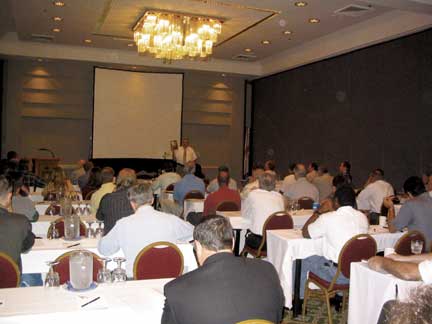 |
| Speaker Clayton Paul drew a full
house in Melbourne, Florida, despite the multiple hurricanes! |
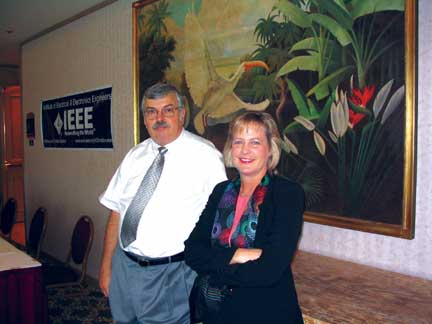 |
| Janet O’Neil of ETS-Lindgren
and Clayton Paul of Mercer University appreciated the enthusiasm
of the members of the Melbourne EMC Chapter shown during the
October Tutorial and Exhibition. |
 |
| The Melbourne EMC Chapter and Section
provided volunteers to staff the registration desk at the
Melbourne EMC Tutorial and Exhibition, including (seated from
left) Bruce Crain, Chris Maginsky, Jed Withers, and Ed Kirchner.
|
 |
| Jack Black did double duty at the
Melbourne event in staffing his booth for DLS Electronics
as well as the booth for the 2005 IEEE International Symposium
on EMC in Chicago. |
 |
| The exhibition area was a fun place
to be and tweak equipment. James Young of Rohde & Schwarz
is shown with Robert Shappell Jr. of Honeywell and Fred Heather
of the Navy Pax River (from left). |
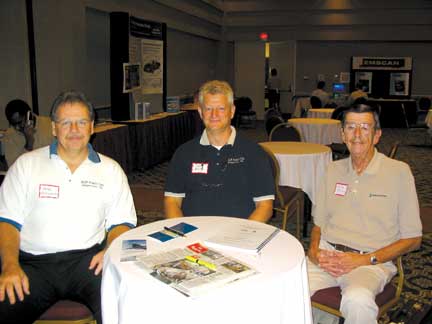 |
| Exhibitors Terry O’Laughlin
and Don Hester of MAJR Products Corp. visited with David Stanis
of WEMS Electronics (from left) during the Melbourne “tabletop
show”. |
 |
| Bruce Crain, one of the organizers
of the Melbourne Chapter’s first ever Colloquium and
Exhibition, enjoyed connecting with attendees Woodrow Corley
and Terry Forsythe (from left). |
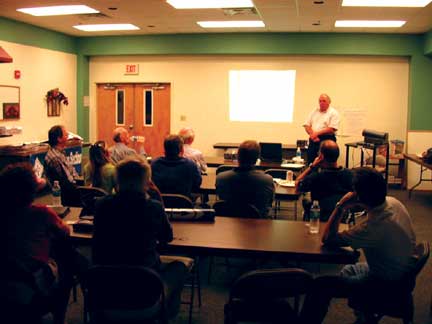 |
| EMC Society Distinguished Lecturer
Dr. Bruce Archambeault of IBM presents “EMI/EMC Computational
Modeling for Real-World Engineering Problems” to the
Melbourne EMC Chapter. |
Nanjing
Wen Xun Zhang reports that the Nanjing Chapter held two meetings
in October. Professor Chang-Hong Liang, of Xidian University,
gave a very helpful presentation to the Chapter on October 14.
His paper was entitled, “A Novel Variational Principle for
Calculation of Capacity in a Coaxial Line with Arbitrary Cross
Section” and was well received by 54 attendees. On October
19, Dr. Zhi-Ning Chen of Instruments for Infocomm Research gave
a great presentation to packed house of 68 attendees. His presentation
on “Ultra Wideband Antennas in Wireless Technology”
was a very timely and popular topic with the audience.
Oregon and SW Washington
Sidney Chan, Chapter Vice Chair, reports that the Oregon and SW
Washington Chapter has been very busy with excellent Chapter meetings
and a holiday social. EMC Distinguished Lecturer Thomas Jerse
spoke at the October Chapter meeting. Thomas Jerse is an Associate
Professor of Electrical Engineering at The Citadel in Charleston,
South Carolina and also an Associate Technical Fellow of the Boeing
Company working as an EMC analyst. His presentation on “The
Role of Symmetry in Producing Common-Mode Emissions” spoke
to common problems that many of us encounter in our profession.
In November, the Chapter had the honor of Elya Joffe coming to
the Chapter meeting all the way from Israel. Elya Joffe is the
Vice President for Engineering at K.T.M. Project Engineering in
Kfar Sava, Israel, and works as a Senior EMC engineering specialist
and consultant. Elya is a very popular speaker with many IEEE
EMC Chapters and similar organizations around the globe. His presentation
was on “Electrophobia, or Why are people really scared of
EM Fields.” His presentation attracted our largest turnout
including a number of electrical engineering students from the
University of Portland. Elya spoke on a serious issue with informative
slides and sense of humor. All who heard his presentation went
away with a better understanding of Electrophobia and its issues.
In December, the Chapter had its annual holiday social. This year,
the event took place at “Who Song and Larry’s Restaurant”
located on the shore of the Columbia River in Vancouver, Washington.
After an excellent dinner, all enjoyed a fabulous view of the
annual Christmas Ship parade. The boats decorated with lights
cruised by just outside the window. There was also a fun “White
Elephant” gift exchange/swipe. All the couples that attended
received a photo of themselves before leaving. In addition to
our monthly Chapter meetings, the Oregon and SW Washington EMC
Chapter and the PSTC is planning a Portland Product Compliance
Colloquium and Exhibition for Monday, April 25, 2005. The Colloquium
will feature EMC, Product Safety and Environmental Regulatory
aspects. Todd Hubing is the featured EMC speaker. The afternoon
session will be on EMC design. Todd will also present a session
in the morning on either integrated circuit EMC or system level
EMC. There will also be a speaker to present a session on current
environmental regulatory hot topics such as the European RoHS
and WEEE Directives. Information about future Chapter meetings
can be found at the following web site: https://www.worldaccessnet.com/~emc/
 |
| Tom Jerse making a point during the
October Oregon and SW Washington Chapter meeting. |
 |
| Attendees relaxed prior to the October
Oregon and SW Washington Chapter meeting. |
 |
| Oregon and SW Washington Chapter
members Henry Benitez (left) and Dave Britton (right) conversed
with speaker Elya Joffe after the November presentation. |
 |
| Speaker Elya Joffe from Israel drew
a full house for the November Oregon and SW Washington Chapter
meeting. |
 |
| Watching the Christmas Ships cruise
by during the Oregon and SW Washington Chapter Holiday Social. |
 |
| There were many couples at the Oregon
and SW Washington Holiday Social! |
Phoenix
Glen Gassaway reports that Bill Parker spoke at the September
30 Chapter meeting in Phoenix, Arizona. Bill began work as an
EMC engineer at Genisco Technology Corporation in 1973. After
various assignments at Genisco, he started his current EMC consulting
business in 1989 and is still going strong. Bill teaches EMC seminars
and provides consulting, testing, and teaching services, as well
as being very active in the IEEE EMC Society. It was also interesting
to hear that Bill is an avid runner, and has even participated
in the LA marathon! Bill’s presentation, entitled “Down
Memory Lane; 30 Years of EMI Field Testing” revolved around
his vast EMI field-testing experiences. He related several “war-stories”
including stories of testing in terrible conditions for long hours,
on-site tests of engine-generators, motor-generators, uninterruptible
power systems, as well as testing portions of larger equipment,
such as a Navy submarine, and even the Space Shuttle Challenger!
He took us ‘down memory lane’ by showing us photos of
older EMI test equipment, bringing back the good old days for
us old-timers. He told us of his exploits in his test equipment
van and how to be fully equipped for an upcoming field test. Bill
had too many stories to list in this article, which could never
do them justice - you just have to hear them for yourself! Bill
concluded his presentation with a discussion of significant lessons
learned throughout the years, for example: using a flashlight,
headphones, and a cheap AM/FM radio on a stick as a diagnostic
tool for evaluating chamber shielding effectiveness. Harry Gaul
reports that the November 20 meeting included a talk given by
David Lee, the Compliance Test Manager for M. Flom Associates
in Chandler, Arizona. In this talk entitled “Demystifying
the Process for Certifying Low Power Transmitters,” David
Lee focused on the rules and processes for certifying low power
transmitters for the FCC, Industry Canada, and the CE Mark (ETSI)
requirements. Dave pointed out that the 47CFR Part 2 contains
all of the “gotchas”, i.e., the rules and core tests
which are then modified by the other parts such as Part 15. He
also pointed out that Specific Absorption Rate (SAR) testing often
requires performing the tests across all the accessories such
as antennas and batteries, and can therefore become quite expensive.
Dave stated that the 47CFR rules are quite intertwined; especially
15.247 for frequency hopping and direct sequence spread spectrum
radios. The RS210 document for Industry Canada is roughly equivalent
to the FCC Part 15 and Part 18. He also said humorously that the
EU is a collection of feudal warring states especially when it
comes to the harmonization of frequency bands. Finally, Mr. Lee
projected that the FCC rules may incorporate immunity tests in
the not-too-distant future. Information on future meetings is
available on the Phoenix EMC Chapter Web site at https://www.ewh.ieee.org/r6/phoenix/phoenixemc/.
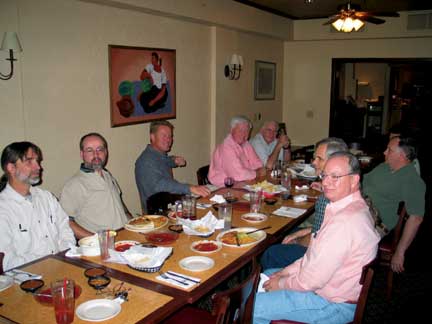 |
| The Phoenix Chapter hosted David
Lee of M. Flom Associates at their November meeting. David
(seated fourth from left on opposite side of table) spoke
on “Demystifying the Process for Certifying Low Power
Transmitters.” |
 |
| Bill Parker provided some valuable
pointers and lessons learned to the Phoenix Chapter for on-site
EMC testing and investigation. |
Santa Clara Valley
Darryl Ray reports the Santa Clara Valley Chapter resumed its
monthly meetings after taking a recess from May through September.
This time, however, the recess included hosting the 2004 EMC symposium
in Santa Clara. In September, the Chapter held its traditional
social and planning meeting. Complementary food and drinks were
provided. This informal gathering was held at Applied Materials
in Santa Clara. As expected, the mood was upbeat as the locals
were still jazzed about the outcome of the EMC symposium. Lots
of smiles and handshakes were observed that night. The October
Meeting featured Mark Briggs of Elliott Laboratories. The topic
was entitled “Managing a Professional Quality Compliance
Laboratory”. Mark reviewed the various aspects of setting
up and running a modern EMC lab. Significant challenges were discussed
such as the extensive (and very expensive) equipment calibration,
lab accreditation, staff training and keeping up with the changes
for the many EMC standards that a commercial lab needs to follow.
In November, Tom Cokenias (Independent Consultant and former Santa
Clara Valley Chapter Chair) presented “Networking over Power
Lines: EMC Considerations” also known as Broadband Over Power
lines or BPL. Tom gave an interesting presentation outlining the
basic technology planned for BPL. Also discussed were the FCC
requirements regulating the use of this new technology. November
was also election month. The following officers were elected for
next season: Bert Chan (Chapter Chair), Hans Mellberg (Vice Chair),
Dale Gutierrez (Treasurer) and Oscar Fallah (Secretary). The December
meeting featured David Seabury from ETS-Lindgren on a talk entitled
“A Review of FCC RF Exposure Requirements for MPE, SAR &
HAC.” The presentation covered the background of RF exposure
standards leading up to the FCC enactment of current requirements
contained under OET65. The OSHA relationship for Maximum Permissible
Exposure limits was explained along with its implication to non-license
holders. FCC OET65 Supplement C 01-01 for SAR was reviewed and
the current scope of FCC reviews including new technologies and
products was presented. Also covered were a review of the new
IEEE STD 1528:2003, the harmonized IEC 62209, and the future work
of 62209 Part II. The presentation concluded with a short discussion
on the new FCC HAC guidance (ANSI C63.19) and the impact on handset
requirements.
Seattle
The Seattle EMC Chapter’s October meeting featured a presentation
by EMCS Distinguished Lecturer Tom Jerse of The Citadel. His presentation
on “The Role of Symmetry in Producing Common-Mode Emissions”
was very enlightening. He led an excellent discussion on the problems
of common mode noise generation from imbalanced circuit layouts
and designs. The meeting was held at CKC Labs in Redmond. Chapter
Chair Pat André noted that several chapter members approached
him after the meeting to tell him how much they learned from and
appreciated Tom’s presentation. In November, Elya Joffe of
KTL Project Engineering in Israel gave a presentation on Electrophobia
at the Redmond Marriott Town Center Hotel. Why are people really
scared of Electromagnetic Fields (EMF)? Some 40 Chapter members
and guests learned that some common claims against EMF include:
“Standards for limiting dangerous exposure were prepared
by biased parties”, “Standards consider thermal effects
only, whereas, many a-thermal effects, including cancer, are not
considered”, “Well known, respectable scientists do
not exclude connection between EMR and cancer”, “Prudent
Avoidance - better be safe than sorry.” The presentation
shed light on the issue of “Electrophobia”. It discussed
the history of EMF usage, the evolution of EMR standards, from
the turn of the 20th century to date, and the evolution of the
public response to the EMF and its usage. While it covered only
technically acceptable figures, statistics etc., it addressed
this controversial issue from a users’ point of view, addressing
the sources of fear, the facts and fallacies, and the risk in…
risk research. The audience at this Chapter meeting was very diverse.
Many new companies, associations, utilities, and universities
in the area were represented. For more information on the activities
of the Seattle EMC Chapter, please visit the IEEE Seattle Section
website at www.ieee-seattle.org.
 |
| Speaker Tom Jerse explains a point
in the background while Seattle Chapter members visit after
the October meeting. |
 |
| Tom Jerse relaxes after a well-done
presentation. Many Seattle Chapter members asked about having
him return for a future meeting! |
 |
| Speaker Elya Joffe provides food
for thought after a nice dinner at the Marriott Hotel, site
of the October Seattle Chapter meeting. |
SE Michigan
Scott Lytle of the SE Michigan EMC Chapter reported on the IEEE
Section Fall 2004 Conference. He served again as the registrar.
169 people registered for the conference. Student activities are
an important part of the SE Michigan Chapter. On November 15,
members of the IEEE Student Chapter from the University of Michigan
at Dearborn were taken on a tour of the Yazaki EMC Laboratory.
Scott Lytle of Yazaki North America cheerfully led the tour! Note
he included his sons on the tour; future EMC engineers perhaps?
 |
| Attendees at the SE Michigan IEEE
Fall Conference on November 10 included (from left) IEEE students
David Ostberg and Theresa Iuliani-Thimm from Lawrence Technology
University, Iasha Yousuf from the University of Michigan and
Scott Lytle of Yazaki North America. |
 |
| The University of Michigan at Dearborn
IEEE Student Chapter conducted a tour of the Yazaki EMC Laboratory
in November. Aaron Theriault, Emily Limchoa, Paul McGuire,
Craig Lytle, Scott Lytle Jr., Teresa Sevonty, Shefali Bhavsar,
Scott Lytle Sr., and Dennis Breton (from left), all participated
on the informative tour. |
 |
| The Yazaki EMC Laboratory tour included
a visit to their reverberation and anechoic test chambers.
Shefali Bhavsar, Iasha Yousuf, Teresa Sevonty, Paul McGuire,
Craig Lytle, Emily Limchoa, Dennis Breton, Scott Lytle Jr.,
and Aaron Theriault (from left) appreciated the quiet environment! |
Spain
The new Spanish Chapter organized its autumn meeting on September
17 at the Technical University of Catalonia (UPC), in Terrassa
(Barcelona). During the meeting, there was the election of Spanish
Chapter Officers, which is now chaired by Dr. Ferran Silva. The
Chapter organized a one-day workshop about “EMC and Disturbances
in the Electrical Network”. Professor Michel Ianoz, from
the Ècole Polytechnique Federale de Lausanne, was invited
as a Distinguished Lecturer of IEEE EMC Society. The subject of
Dr. Ianoz’ presentation was “EMC Problems Related to
Transient Phenomena in Power Network Substations.” Professor
Ianoz outlined a detailed report of problems associated with EMC
in electronic systems working in electrical substations with significant
data recorded since 1990 and also on recent measurement campaigns.
50 people, including IEEE EMC Society members and EMC engineers
from numerous Spanish companies, attended the meeting. EMC
 |
| Professor Ianoz presented a
well-received lecture to the new Spanish Chapter in September. |
 |
| Professor Michel Ianoz is shown with
the new Spanish EMC Chapter Officers at the September Chapter
meeting, including (from left) Miquel Ribó, Josep Balcells,
Michel Ianoz, Ferran Silva and Juan V. Balbastre. |
|
|
|
 Chapter
Chatter
Chapter
Chatter 












































